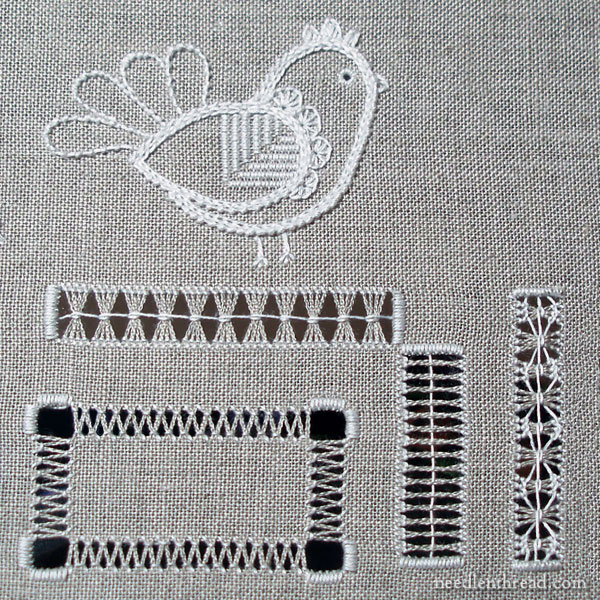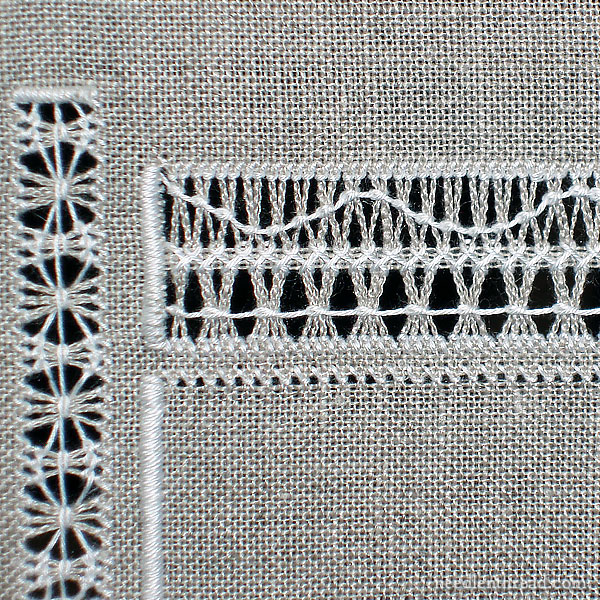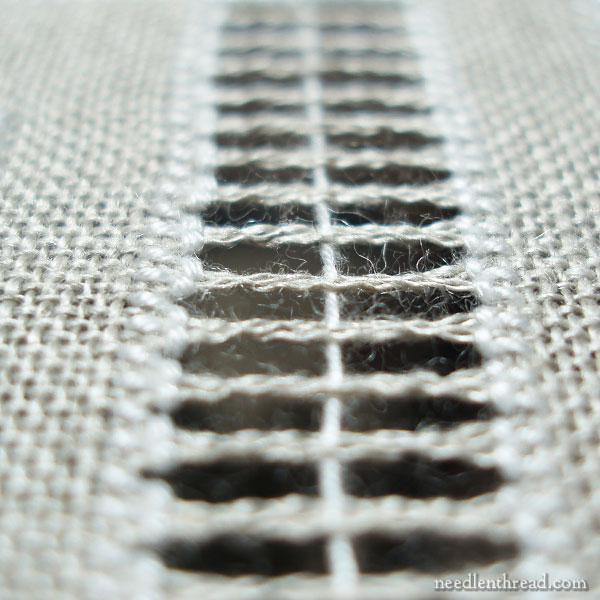Today, we’ll take a quick delve into the archives here on Needle ‘n Thread and touch on some embroidery techniques that I really, really love but that I haven’t had a lot of time to indulge in.
I’m remedying that with the next Stitch Snippet project that will launch in July (it’s called Sweet Marguerite – and it is little and sweet). In this project, we will work a decorative hemstitch edge on the piece, involving drawn thread embroidery.
Drawn thread techniques can seem daunting – after all, you’re removing threads from the ground fabric! – but it’s not. Not at all! And the results can be very satisfying.
Adding some simple drawn thread techniques to your embroidery repertoire is a great idea, because they work so well for finishing embroidered goods, especially household goods like tablecloths, cloth napkins, towels, table runners, placemats, and the like.
So let’s see what’s in the archives, shall we?

Deep among the earlier projects that I blogged about on Needle ‘n Thread was a moderately strange sampler that featured some whitework and some drawn thread bits. And a chicken.
The purpose of that piece – which was never a “finished” piece – was just to explore some techniques here on the blog and experiment.
I do a lot of that. It doesn’t necessarily result in much, but it does give a little direction and hopefully acts as a springboard for folks to explore more on their own.

In the drawn thread archives, you’ll find articles in which we looked at different ways of preparing fabric for drawn thread work and of finishing the edges where the threads are removed.
We explored hemstitch by hand, and we looked at various ways of decorating drawn thread bands.
All of the techniques are pretty simple, but they yield lovely, lacy results!

I think the thing that fascinates me most about drawn thread embroidery is that you remove threads from the ground fabric, and then you manipulate the threads that are left.
Whenever I’ve indulged in drawn thread embroidery, my mind has always wandered to the question of firsts: who was the first person who taught it a good idea to actually take out the structural threads of fabric and re-structure the remaining threads into something decorative? What was that moment of experimentation and discovery like? Because there had to be a first person who said, “Hey, I bet if I pull this thread out, I could (achieve this)…” and then who did it! And achieved it!
Whoever it was, that person had a great idea!
So…. if you want to explore the bits of basic drawn thread work that are available here on Needle ‘n Thread, you’ll find an index here for various tutorials.
In the not-too-distant future, we’ll be exploring drawn thread work again on Sweet Marguerite, so keep an eye out for the next Stitch Snippet, coming soon!







Merci
J’adore la broderie blanche
As for that first person to do this? I suspect it went something like this: They had a piece of fabric that they loved, but somewhere along the way it was damaged. Maybe a puppy chewed the edge of it. (I had that happen to a completed piece of embroidery!) So you pull out a few more threads to make it even, and then figure out a way to make it look pretty. And voila! A new form of embroidery!
Love this! 🙂
Very interesting!!
Or it could have been someone wanting to salvage a piece of linen that got a chunk cut out of it by accident. Or on purpose by another person jealous of the stitcher’s skills. Or maybe somebody was pulling threads from one linen to re-weave into a stitched piece to repair that, then looked at the donor linen and started experimenting.
Drawn thread work is gorgeous. I did one project that had drawn thread areas, yet I haven’t done one since. No idea why, as I was fascinated how weaving another thread through and around the remaining ground fabric threads made a design. Maybe it’s the tension of making those first thread cuts? I’m looking forward to seeing Sweet Marguerite!
I’m thinking a very frugal woman needed some thread to stitch something and as Gee suggested, she removed some threads from a previous fabric to stitch with. Since she was so frugal, she looked at where the threads were removed and thought, “Now how can I do something with these spaces and still use this fabric.” 🙂
Karen M.
Oooh! Drawn thread! I can’t wait!
There is a weaving technique called leno, which looks a lot like drawn thread – as you’re weaving the cloth, you actually rearrange the warp threads (crossing bundles over and under) and hold them in place with the weft. I have been learning about weaving (because, like all fiber artists, I just don’t have enough hobbies) and as soon as I saw a picture of leno, my mind went straight to drawn thread. No idea which came first (or, more likely, convergent evolution many times over), but it’s very cool to see different ways of achieving the same look with different media.